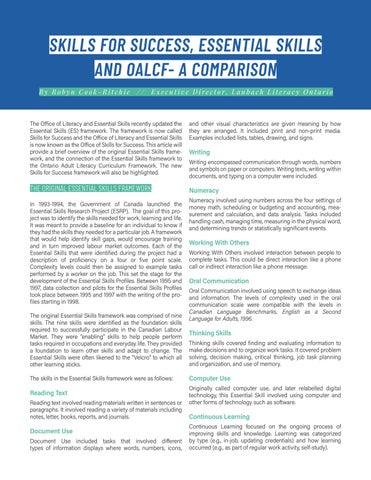Skills for Success
SKILLS FOR SUCCESS, ESSENTIAL SKILLS AND OALCF- A COMPARISON By Robyn Cook-Ritchie
//
Executive Director, Laubach Literacy Ontario
The Office of Literacy and Essential Skills recently updated the Essential Skills (ES) framework. The framework is now called Skills for Success and the Office of Literacy and Essential Skills is now known as the Office of Skills for Success. This article will provide a brief overview of the original Essential Skills framework, and the connection of the Essential Skills framework to the Ontario Adult Literacy Curriculum Framework. The new Skills for Success framework will also be highlighted.
THE ORIGINAL ESSENTIAL SKILLS FRAMEWORK In 1993-1994, the Government of Canada launched the Essential Skills Research Project (ESRP). The goal of this project was to identify the skills needed for work, learning and life. It was meant to provide a baseline for an individual to know if they had the skills they needed for a particular job. A framework that would help identify skill gaps, would encourage training and in turn improved labour market outcomes. Each of the Essential Skills that were identified during the project had a description of proficiency on a four or five point scale. Complexity levels could then be assigned to example tasks performed by a worker on the job. This set the stage for the development of the Essential Skills Profiles. Between 1995 and 1997, data collection and pilots for the Essential Skills Profiles took place between 1995 and 1997 with the writing of the profiles starting in 1998. The original Essential Skills framework was comprised of nine skills. The nine skills were identified as the foundation skills required to successfully participate in the Canadian Labour Market. They were “enabling” skills to help people perform tasks required in occupations and everyday life. They provided a foundation to learn other skills and adapt to change. The Essential Skills were often likened to the “Velcro” to which all other learning sticks.
and other visual characteristics are given meaning by how they are arranged. It included print and non-print media. Examples included lists, tables, drawing, and signs.
Writing Writing encompassed communication through words, numbers and symbols on paper or computers. Writing texts, writing within documents, and typing on a computer were included.
Numeracy Numeracy involved using numbers across the four settings of money math, scheduling or budgeting and accounting, mea surement and calculation, and data analysis. Tasks included handling cash, managing time, measuring in the physical word, and determining trends or statistically significant events.
Working With Others Working With Others involved interaction between people to complete tasks. This could be direct interaction like a phone call or indirect interaction like a phone message.
Oral Communication Oral Communication involved using speech to exchange ideas and information. The levels of complexity used in the oral communication scale were compatible with the levels in Canadian Language Benchmarks, English as a Second Language for Adults, 1996.
Thinking Skills Thinking skills covered finding and evaluating information to make decisions and to organize work tasks. It covered problem solving, decision making, critical thinking, job task planning and organization, and use of memory.
The skills in the Essential Skills framework were as follows:
Computer Use
Reading Text
Originally called computer use, and later relabelled digital technology, this Essential Skill involved using computer and other forms of technology such as software.
Reading text involved reading materials written in sentences or paragraphs. It involved reading a variety of materials including notes, letter, books, reports, and journals.
Document Use Document Use included tasks that involved different types of information displays where words, numbers, icons,
Continuous Learning Continuous Learning focused on the ongoing process of improving skills and knowledge. Learning was categorized by type (e.g., in-job, updating credentials) and how learning occurred (e.g., as part of regular work activity, self-study).
9





